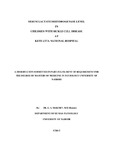| dc.description.abstract | Background
Sickle Cell Disease (SCD) an inherited condition caused by a point mutation in the β- globin
gene of hemoglobin. The laboratory diagnosis of SCD at Kenyatta national hospital (KNH) is
through hemoglobin electrophoresis. At KNH, the follow up of patients with Sickle SCD aims at
preventing malaria, pneumococcal infections and folate deficiency. Hydroxyurea is also
prescribed to reduce the occurrence of certain SCD complications. Low socio-economic status
coupled with lack of awareness about the disease in many of SCD patients is a hindrance to early
diagnosis and contributes to poor adherence to treatment, shortened life expectancy, frequent
sickle cell crises and early occurrence of complications. This has stimulated studies looking into
the use of already existing, less expensive, effective laboratory tests for the detection of
complications with possibilities of recommending their use in the routine follow up of SCD
patients. This study was undertaken to look at serum lactate dehydrogenase (LDH) in SCD to
find out if as a marker of hemolysis, its elevation would correlate with the clinical manifestations
of the disease and the occurrence of complications.
Objective
To characterize the patterns of serum LDH levels among children with SCD aged 1-13 years
attending Kenyatta National Hospital (KNH).
Study design and setting
Descriptive cross-sectional study conducted at the pediatric hematology clinic, pediatric filter
clinic and the pediatric wards of KNH. The biochemical laboratory tests were done at the KNHclinical
chemistry laboratory and the hematology tests were done at the University of Nairobi
(UON) hematology laboratory.
Methods:
A total of 145 children with SCD aged 1 to 13 years were recruited into the study after an
informed consent was signed by their parents or guardians. A questionnaire to collect data on age
gender, presenting complaint, current medication used and recent medical history in the last one
year was filled. Blood samples were collected for the total blood cell count, peripheral blood
film, reticulocyte count and the total serum LDH level.
Data handling
The generated data from the questionnaire, the medical examination and the laboratory tests was
entered into a computer data base, cleaned and analyzed through statistical software for analysis:
SPSS (version 17.0). The results were expressed in graphs and tables and presented in
mean/median and percentages.
Results
A total of 145 children were recruited into the study. Males were 57.2% while females were
42.8% and the median age was 5years (IQR: 3.0 - 9.0). The disease duration had a median of 36
months (IQR: 13 - 36 months). Hydroxyurea therapy was documented in 43.4% of the
participants. The complications diagnosed at the time of presentation were thrombotic events
accounting for 47.4% and these were represented by painful crises in 31.6%, neurological
complications in 10.5% and skin ulcers in 5.3%; hemolytic complications were documented in
5.2% of participants while the presence of infections was documented in 47.4% patients.
Serum LDH levels were measured in all the participants and a mean of 628 IU/L (reference
range: 180- 360 IU/L) recorded. Majority of participants (93.8%) had serum LDH levels values
above the reference range. Anemia was present in 97% participants and leukocytosis in 59%
patients. Platelets counts within reference range were recorded in 80 % of the participants. No
significant correlation was demonstrated between the serum LDH levels with the disease severity
or the presence of complications. The study findings established a significant relationship
between the elevation of serum LDH level and gender whereby male participants were
predominant in the group with high serum LDH level. There was a significant correlation
between the elevated serum LDH levels and presence of anemia. No statistically significant correlation was found between the serum LDH level, the white blood cells, platelet or the
reticulocyte count.
Conclusion:
This study established a mean serum LDH level of 628.8 IU/L in children with SCD attending
KNH. The most commonly diagnosed complications at presentation were thrombotic events and
infections each documented in 47.4% patients. These complications showed no correlation with
serum LDH level. Although a significant correlation between elevated serum LDH with gender
and presence of anemia was seen, no significant correlation was found between the serum LDH
levels, the WBC count, platelets count or the reticulocyte count. This study demonstrated that in
children with SCD at KNH the serum LDH level is not a marker for severity of the clinical
manifestation or predictor of complications of the disease.
Study recommendations:
From this study findings, serum LDH level may be used to predict for the presence of severe
anemia in children with SCD at KNH. It however cannot be used as a marker of severity or to
predict for disease severity and occurrence of complications. | en_US |
| dc.description.department | a
Department of Psychiatry, University of Nairobi, ; bDepartment of Mental Health, School of Medicine,
Moi University, Eldoret, Kenya | |

